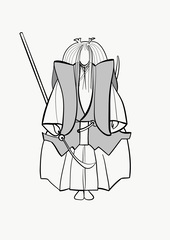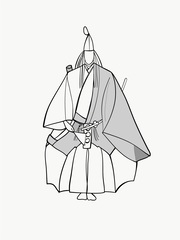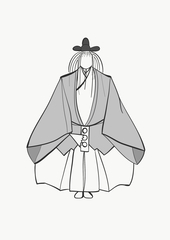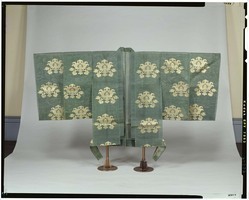Happi
はっぴ 法被
A happi is a broad-sleeved (ōsode 大袖) noh costume worn as an outer garment for strong male roles. Lined awase happi woven with dynamic gold designs are worn by characters of demons, menacing animals, lesser gods and victorious warriors. Happi woven with multicolor patterns serve as a Chinese dress, while unlined hitoe happi woven in a gossamer gauze with gentler patterns may represent the armor worn by warrior courtiers.
Noh Kyogen
Roles and draping
For demons and lesser deities, the happi is belted over hangiri 半切 with the wide sleeves falling free. Warriors might wear the happi with the right sleeve slipped off (nugisage) so they can wield a sword or halberd (as in Yashima 屋島) or with both sleeves hiked up (as in Funa Benkei 船弁慶). The Chinese immortal who guards the elixir of long life in the play Kiku-jidō (菊慈道, also known as Makura-jidō 枕慈道) also has the right sleeve slipped off, but carries a round Chinese-style fan (tō-uchiwa).



Tailoring
The happi has double-width, open cuffed sleeves attached around the shoulder area to three-quarter length body panels. The front panels have no extra lapels, but are edged by a straight collar. The cloth bands at the hem of the body panels connecting front to back at the side are a salient feature.
Textile Features
Lined happi are woven with a twill or satin foundation and supplementary weft patterning, in gold or silver thread, or with colored pattern threads. The gossamer unlined happi are woven in simple gauze weave (sha) or ribbed gauze (ro) with supplementary patterning in gold, silver, or colored threads. Some happi have stenciled or painted designs.
Designs and Colors
Lined happi have bold designs that are often geometric or suggestive of Chinese imagery, with larger motifs predominantly used for stronger characters, like demons and bandits. Background colors may be white, blue, green, or purple. Unlined happi can be either plain or patterned with arabesques, insects, flowers, or court motifs (yūsoku monyō on white, blue, green, or purple grounds.

Unlined happi with karahana flower patterns on a green ground. Edo period. Tokyo National Museum.
http://webarchives.tnm.jp/imgsearch/show/C0065512
Contributor
Monica Bethe